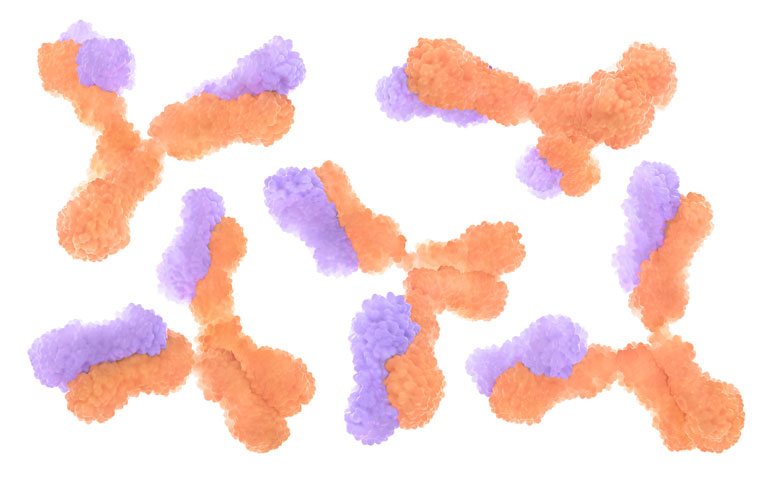The biologics have revolutionised the management of patients with moderate-to-severe psoriasis but how do clinicians decide which treatment to use? A recent study has shed light on this important question.
Patients with moderate-to-severe psoriasis, that is, where more than 10% of their body surface area is affected, are normally managed with a group of monoclonal antibody drugs (biologics). The biologics were introduced in the early 2000’s and the initial agents worked by inhibiting the pro-inflammatory cytokine, tumour necrosis factor which is secreted by both T cells and antigen-presenting cells within lesional skin.1 This initial group of drugs which included etanercept, infliximab and adalimumab became known as ‘first-generation’ biologics and represented a significant treatment advance for those with more widespread disease. Nevertheless, most patients failed to achieve complete clearance of their disease and more recent advances in our understanding of the pathophysiology of psoriasis led to the development of a wider range of specific cytokine inhibitors that provided a greater level of skin clearance. These ‘second-generation’ biologics such as secukinumab, izekizumab, brodalumab, guselkumab, risankizumab and ustekinumab, targeted interleukin (IL)-17 and IL-12/23.2
A greater range of treatment options is welcomed by clinicians and patients allowing shared decision-making. In order for both parties to make an informed choice about a particular treatment requires insight of the relative efficacy of the different options. While head-to-head trials are of value when comparing two agents, more information can be gleaned from meta-analyses because data is pooled from all of the available head-to-head studies and this offers a more robust efficacy estimate. However, differences in the design of trials, for example, patient inclusion criteria, prior treatment exposures, study duration and lack of comparative data for a particular intervention, can all potentially impact on the outcome of a meta-analysis. One potential solution to the problems faced by meta-analyses is to use a network meta-analysis (NMA). This technique not only compares the outcomes from head-to-head trials but also includes indirect comparisons across trials.3 In short, an NMA can be used to evaluate the comparative effectiveness of different interventions (in this case biologics) even where there are no trials in which the two agents have been compared directly.
In the February 2020 issue of JAMA Dermatology, an NMA study sought to provide greater clarity on the short and longer term efficacy of both oral and biologic therapies in psoriasis to help clinicians and patients in their decision-making process.4 The study used a NMA to examine the relative efficacy of the various treatments in the short-term (10 to 16 weeks) and then used a traditional meta-analysis to explore the longer-term (44 to 60 weeks) response rate. It included Phase II, III or IV randomised trials of treatments licensed by the US Food and Drug Administration and the European Medicines Agency for adults with moderate to severe psoriasis. This included not only all of the biologics but also oral treatments such as apremilast (Otezla) and dimethyl fumarate (Tecfidera).
The main outcome measure was a change in the Psoriasis Area and Severity Index (PASI) score, which evaluates disease severity. Typically, trials report a PASI 75, 90 or 100, which describes the improvement in disease severity attained by the intervention. For instance, a PASI 75 indicates that a patient achieved a 75% reduction in PASI score (compared to baseline) from the treatment and a PASI 100, represents complete clearance of psoriasis. The study identified 60 studies and found that after 10 to 16 weeks of treatment, the highest PASI 90 rates were achieved with four biologics, risankizumab (71.6%), brodalumab (70.8%), izekizumab (70.6%) and guselkumab (67.3%) and these differences were not statistically significant. In the longer term (weeks 44 to 60), the highest PASI 90 rates were achieved by, risankizumab (79.4%), guselkumab (76.5%), brodalumab (74.0%) and izekizumab (73.9%).
In contrast, the first generation biologics, infliximab and etanercept only achieved PASI 90 rates of 57.4% and 17.9% respectively. These improvements are impressive and serve to illustrate the benefits of these newer agents over the first-generation biologics. In practice, the results suggest that with these newer agents, after 4 months of therapy, roughly 70% of patients can expect to see a 90% reduction in disease severity and that efficacy is also retained in the longer term. The short-term efficacy (i.e. up to 16 weeks) data obtained in this study are comparable to the results observed in another NMA which found that brodalumab, Ixekinumab exhibited similar efficacies to risankizumab.5
The latest JAMA study therefore suggests that in order to achieve the greatest improvement in disease severity in both the short and longer term, biologic therapy should be restricted to one of the following; brodalumab, guselkumab, ixekinumab or risankizumab since these drugs provide the highest PASI 75, 90 and 100 rates.
This recent NMA has therefore provided an important starting point to inform the clinical decision-making discussion between clinicians and patients although whether or not the small differences in response between the biologics have real-world implications remains to be seen.
References
- Yost J, Gudjonsson JE. The role of TNF inhibitors in psoriasis therapy: new implications for associated co-morbidities. F1000 Med Rep 2009;1:30.
- Ronholt K, Iversen L. Old and new biological therapies for psoriasis. Int J Mol Sci 2017;18(11):2297-320.
- Mills EJ, Thorlund K, Ioannidis JPA. Demystifying trial networks and network meta-analysis BMJ 2013;346:f2914
- Armstrong AW et al. Comparison of biologics and oral treatments for plaque psoriasis A meta-analysis. JAMA Dermatol 2020; Feb 5 [Online ahead of print].
- Sawyer LM et al. Assessing the relative efficacy of interleukin-17 and interleukin-23 targeted treatments for moderate-to-severe psoriasis: a systematic review and network meta-analysis of PASI response. PLoS One 2019;14(8):e0220868.










